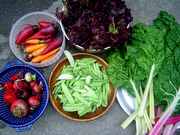

|
| Vegetable Varieties for Gardeners is a citizen science program
|
|
|
|
'Hidatsa Red' Beans |
| |
| Sub-Category: |
Bush
Dry
|
| |
|
| Sub-Category 2: |
| | Description: |
Bush dry bean of Native American origin. Semi-twining plants bear pods with deep-red seeds with occasional white sports. Also listed as Hidatsa Indian Red.
|
| Days To Maturity: |
80
|
| Seed Sources: |
Seed Savers Exchange - updated in 2014
|
| |
| Rating Summary |
| |
Overall: (5.0 Stars)
Taste: (4.5 Stars)
Yield: (5.0 Stars)
Ease/Reliability: (5.0 Stars) |
| |
| Reviews |
| |
Login to share your Review of Hidatsa Red.
Number of Reviews: 2
KEY: O=Overall Rating, T=Taste, Y=Yield, E=Ease
Reviewed on 07/06/2012 by
Ferdzy
- An intermediate gardener
|
 Overall Overall
 Taste Taste
 Yield Yield
 Ease Ease
|
Ontario, Canada
Frost Free Season: 143 - 163 days
Soil Texture: Sand
Garden Size: Large - More than 1,600 square feet (40' x 40')
Sun Exposure: More than 8 hours per day
|
| Grew these last summer and just got around to cooking them up. Very nice bean, like a bit rounder kidney bean. The plants are bush but send out a lot of runners, so they end up pretty snarly. It is important to keep the edges of the bed around them trimmed or they will run off into the grass and get wet and rot. These were quite productive; I got about 6 cups shelled beans from a 4 foot by 5 foot planting. Somewhat long season but easy and productive. |
| | | 1 of 1 gardener found this review helpful.
|
|
Reviewed on 10/11/2008 by
starflakes
- An experienced gardener
|
 Overall Overall
 Taste Taste
 Yield Yield
 Ease Ease
|
Roberts, South Dakota, United States
Frost Free Season: 103 - 123 days
Soil Texture: Sand
Garden Size: Large - More than 1,600 square feet (40' x 40')
Sun Exposure: More than 8 hours per day
|
| I purchased my seeds from Sand Hill 3 years ago. My first crop was a bad year and my second year the plants flooded out.
This year I was surprised I had a few seeds left in a packet, so planted them by a hog panel for support.
The plants did well in a drought on gravel soil. I did water to get them through. They seem late for the north in needing an entire summer to produce.
All of my seed did not germinate, but of about 15 plants I had what must be a few hundred seeds in return which is very good for here.
They are a beautiful deep red seed and I did have the white sport show up, but the white seeded plant seemed to produce a later bean with a bigger pod which seemed a bit larger in seed size.
What impressed me was I sampled one pod in the green stage and I thought it was even better than green bean varieties. I don't know if these beans would produce enough for a green bean crop, but in dual purpose the flavor is there.
I will be growing these again, including the white isolated to see what becomes of it.
Am so pleased these old Dakota beans are available to enjoy. |
| | | 1 of 1 gardener found this review helpful.
|
|
|
|
|
Vegetable Varieties for Gardeners is a citizen science program, © 2004-2024, All Rights Reserved
Cornell Garden Based Learning, Cornell University College of Agriculture & Life Sciences, Horticulture Section
|






 VVfG home
VVfG home
 Taste
Taste